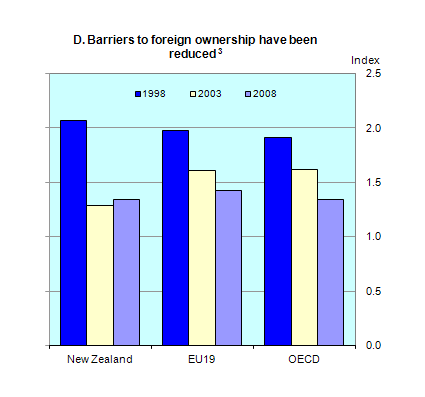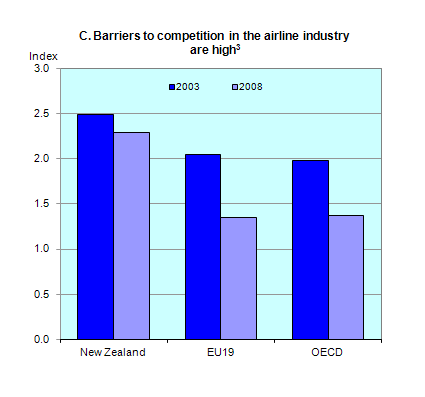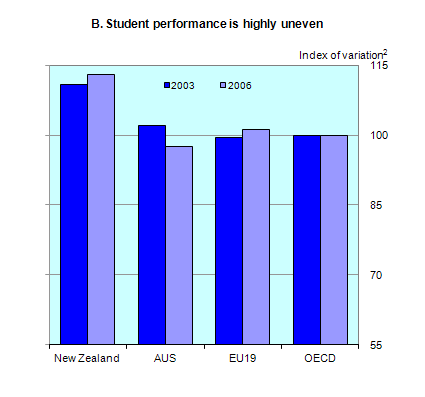New Zealand: New Zealand Finance Profile 2012
2012/03/21
New Zealand Finance Profile 2012
New Zealand: Developments in Regulatory Reform
Key features of New Zealand’s regulatory reform
In the 1980s and early 1990s, New Zealand both significantly deregulated its economy, and adopted new regulatory approaches that were intended to facilitate the efficient functioning of markets while at the same time providing adequate levels protection in areas such as health, safety, the environment, consumer protection and financial stability. In the following decade there have been a number of developments, including:
Evolution of the regulatory frameworks that apply to network industries such as electricity and telecommunications, and financial markets.
The introduction and adoption of a Regulatory Impact Analysis (RIA) regime.
A range of initiatives to reduce regulatory costs and streamlining the interface between business and government. In November 2008, there was a change in government and this has resulted in a renewed focus on regulatory reform with an overall goal of improving New Zealand’s productivity performance. The government sees Australia as a benchmark, and has established a goal of closing the income gap with Australia by 2025. This will require a sustained lift in New Zealand’s productivity growth rate to at least 3% a year.
This renewed focus on regulatory reform is reflected in the appointment of a Minister for Regulatory Reform. The reform agenda includes initiatives to reduce red tape and regulation that is impacting negatively on investment and employment. It also includes the consideration of a Regulatory Responsibility Bill. This aims to create in statute law principles of responsible regulatory management.
Proposals for regulatory reform and a strengthened regulatory quality system generally are still being developed. It is likely that new initiatives will be taken in the following months.
Mechanisms and institutions to oversee regulatory reform
The New Zealand Treasury provides strategic oversight of the regulatory reform programme and the regulatory quality system. In this role it carries out the following main functions:
Coordination, development and advocacy in relation to the regulatory quality system as a whole.
Administration of the Regulatory Impact Analysis (RIA) regime. All regulatory proposals that are submitted to Cabinet are subject to the RIA requirements and require a Regulatory Impact Statement (RIS). The RIA and the RIS for regulatory proposals that are economically significant are assessed for adequacy by the Regulatory Impact Analysis Team (RIAT) of the Treasury.
Development of a rolling programme of reviews of existing regulation.
The Ministry of Economic Development (MED) provides strategic oversight of the impact of regulation on the business sector. In this role it carries out the following main functions:
Assessment of the impact of regulation on business, with a particular focus on compliance costs.
Identification of specific opportunities to reduce regulatory costs, and administration of an annual Regulatory Reform Bill that consolidates changes to primary legislation where these have a cost-reduction objective.
Coordination of initiatives to reduce regulatory costs that arise for firms operating in both New Zealand and Australia.
The Treasury and Ministry of Economic Development work closely together on the regulatory reform programme, and both agencies provide second-opinion advice of regulatory proposals that originate in other agencies, from an economic development perspective.
There are a range of other institutions that focus on various dimensions of regulatory quality. These include the Legislation Advisory Committee (LAC) and the Legislation Design Committee (LDC). The LAC is a committee of experts that develops and publishes guidelines for good regulatory design. The LDC is a committee of experts that review particularly novel or complex regulatory proposals and provides advice to the originating departments.
New initiatives being considered by the government involve the strengthening of parliamentary processes for assuring high-quality regulation through enacting a Regulatory Responsibility Act, and Executive processes through a further strengthening of the RIA regime.
Improving the quality of regulation
Regulatory tools, systems and processes for improving the quality of new regulations
(Flow)
Regulatory Impact Analysis (RIA) requirements have been in place for some 10 years. It is established as an administrative requirement. All regulatory proposals submitted to the New Zealand Cabinet must be accompanied by a Regulatory Impact Statement (RIS). As noted above, the Regulatory Impact Analysis Team (RIAT) assesses all economically significant proposals for adequacy and reports on its assessment to the Minister of Finance and Minister for Regulatory Reform. Non-economically significant proposals are assessed by the originating agency and selfcertified.
Responsibility for the RIA regime was shifted from the Ministry of Economic Development to the Treasury in November 2008. The objective was to strengthen the RIA regime by moving it into a central government agency and to shift the focus from an emphasis on the impacts of regulation on business to a broader focus on the economic impacts of regulation. As part of the renewed focus on better regulatory quality, options for further strengthening the RIA regime are currently being evaluated.
New Zealand is in the process of implementing a Business Cost Calculator (BCC). The BCC was developed by the Australian Department of Finance and Deregulation in association with the Ministry of Economic Development, and adapted for use in New Zealand. The BCC is for use by government agencies when developing new regulatory proposals. It permits more precise information to be produced on the likely compliance cost impacts on business of the proposed regulation, and opportunities to reduce these costs, for example through streamlining processes.
In addition, it should be noted that New Zealand has a strong tradition of consultation on regulatory proposals, and consultation is often a legal requirement. New Zealand also emphasises evidencebased policymaking. Regulatory proposals are therefore expected to reflect input from affected parties and experts, although the information base is generally qualitative rather than quantitative.
New initiatives being considered by the government are strengthening parliamentary processes for assuring high quality regulation through enacting a Regulatory Responsibility Act, and Executive processes through a further strengthening of the RIA regime.
Regulatory tools, systems and processes for improving the quality of existing
regulations (Stock)
The renewed focus on regulatory reform is reflected in a more systematic approach to the review of existing regulation. A 2009 regulatory reform programme has been initiated, focusing on areas of regulation that have a significant impact on productivity, investment and employment.
It is intended that the reform programme be embedded in the regulatory quality system with the intention that all regulation is systematically reviewed on a rolling basis. The precise mechanisms to activate and undertake the reviews are still under development.
Future challenges and lessons learnt in promoting regulatory reform
New Zealand has a tradition of substantive regulatory reform going back to the mid-1980s. The lesson from the past is that the commitment to regulatory reform needs be revitalised from time to time. This is particularly important given ongoing pressures for more regulation.
The challenge going forward is to embed stronger disciplines on regulation-making and undertaking ex post reviews in the regulatory quality system. The disciplines that have been foreshadowed by the incoming government, including the Regulatory Responsibility Bill and a more systematic reform programme, are in response to this challenge.
More information on New Zealand’s regulatory management system can be found on the New Zealand Treasury website: http://www.treasury.govt.nz/economy/regulation



- New Zealand News
-
- NEW ZEALAND: New Zealand December Building Permits Climb 2.3%
- MALAYSIA: The pilot questioned why the plane leaving from Auckland airport was not taking a more direct route to Kuala Lumpur
- NEW ZEALAND: New Zealand Food Prices Fall 0.2% In November
- BRUNEI : APEC economies growth slows to 3.1 pct in Q2
- JAPAN: The ambitious TPP trade deal full text of 6.000 pages released to the public
- NEW ZEALAND: New Zealand is courting a new trade deal
- Trending Articles
-
- CHINA: Chinese Developers Delay Bond Maturity, Deficit to Peak in 2020
- ITALY: The Child Migrants of Africa
- AFRICA: More than 41 million in southern Africa face food insecurity
- INDIA: Indian central bank chief to step down in surprise move
- SOUTH AFRICA: South Africa to limit farm sizes to speed land redistribution
- KAZAKHSTAN: Kazakhstan reveals grain export volumes









